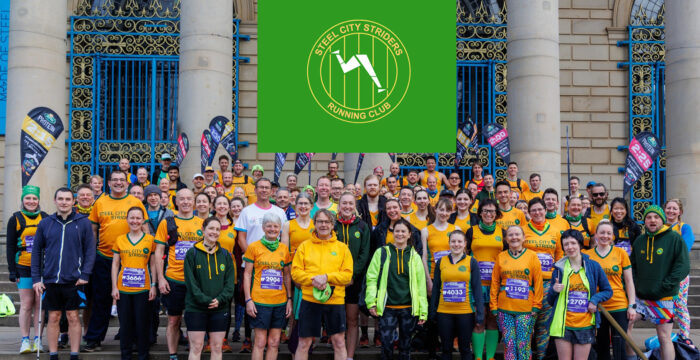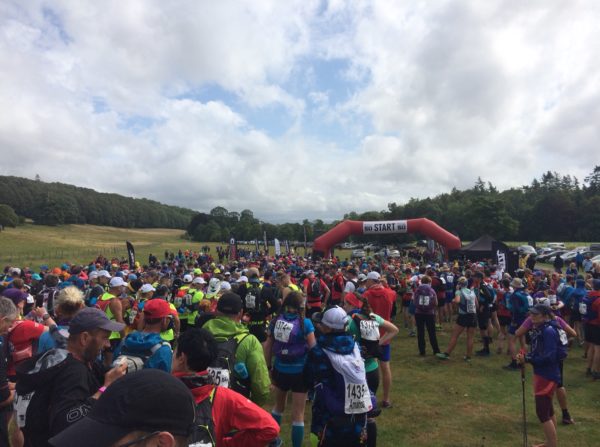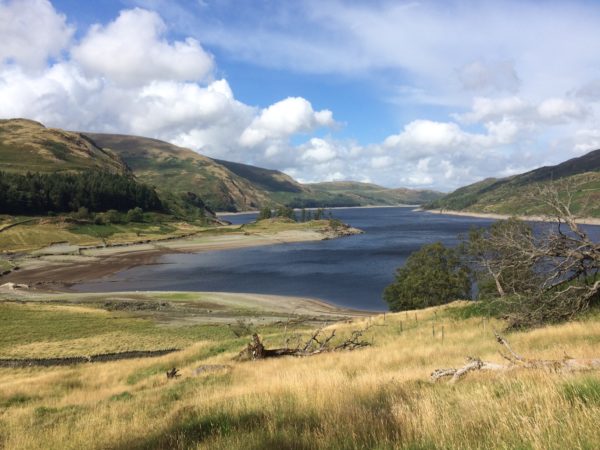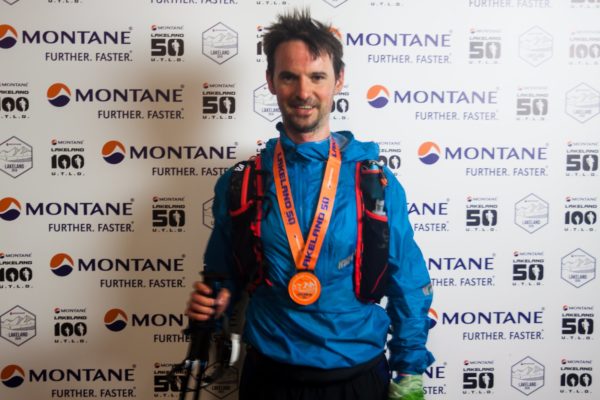Race Date: July 28th, 2018
The Lakeland 100 is an epic tour of the Lake District starting and finishing in Coniston. At 105 miles and getting on for 7000m of climb, it’s a challenge even for experienced ultra runners. Despite vetting applicants, the drop-out rate is around 50%. So there’s no way I was going to do that then.
Fortunately for those who like the idea of the Lakeland 100 but don’t have the legs or the mentality for it, it has a slightly more achievable support race, the Lakeland 50. Last year I started testing the water in ultras, running the flat Waterway 30 and Grim Reaper 40 races. This year I thought I was ready to have a go at a real one, and this seemed perfect.
At 6pm on the Friday evening, the L100 runners lined up in Coniston, stared pensively into the middle distance while Nessun Dorma was played, and set off, heroes every one of them just for crossing the line.
Mr Fox then emerged to lead the warm-up for the main event of the weekend: the Lakeland 1. Several hundred children ran down to the lake and back, collecting an exclusive “Future Lakeland Legends” fox buff for their efforts. Not bad for a free event.
My two kids found that without the hills they’re used to from Graves Junior Parkrun, running is easy, and loved every second of it. Their only complaint was that they couldn’t really see Mr Fox during the warm-up as they weren’t close enough to the front. My suggestion to the organisers that next year Mr Fox could spend half an hour high-fiving children at the finish line wasn’t well-received. Apparently spending up to 40 hours running 105 miles is possible, but standing in the sun in a fox costume for 30 minutes is a feat of endurance too far. Something to do with animal cruelty, presumably.
Anyway, all that done, we L50 runners had our kit checked, weighed in, ate pasta, and retired to our tents to sleep through the first half of the race. The next morning we’d get the bus to the halfway point, where we’d join the intrepid souls who’d been running through the night for the journey back to Coniston. Nothing like a bit of fully sanctioned cheating to make an event accessible to mortals.
After days of baking heat, the weather broke soon after dusk, rain drilling into canvas with threats for the following day. I tried to ignore it and get some sleep. The next morning, I emerged from my tent in full waterproofs, apprehensive but ready to face the weather. I’d forgotten how much worse rain sounds when you’re in a tent: outside it turned out that it wasn’t actually that bad.
After the race briefing, we boarded the buses. The race route is unmarked, but I’d studied it on the course map, and had the GPX file loaded into my new Forerunner 735XT (bought for its battery life and navigation features) to warn me if I went off it. Chatting to other people, everyone else had either done the race before or attended recce days. This made me feel underprepared, but on the other hand I figured that if everyone else knew where to go I’d probably be okay following them.
When we arrived at Dalemain, the venue for our start, we had about an hour to get ready and dump our bags. Any time left over was spent cheering L100 runners through the checkpoint there and feeling relieved we weren’t them.
I was feeling pretty relaxed. My training had been pathetic, so I’d scrapped any plans I had to race, added a couple of hours to my finger-in-the-wind, stab-in-the-dark, fantasy target time, and decided to take it very easy right from the start. I figured if I could get to 30 miles before I started to fall apart, then I could probably drag myself to the finish. If I could do that in less than 12 hours I’d be delighted.
We started with a 6k loop of the Dalemain estate to top up the distance to 50 miles and string us out before we moved onto narrower paths. There were a few short hills, which I walked, and some closed gates, which I queued at, all keeping my heart rate firmly in zones 1 and 2. No need to tell the legs what we were up to until much later on.
Around this loop, my watch buzzed several times to tell me I was off-route, then back on-route, then off again. This intermittent buzzing continued throughout the race, draining the battery faster than usual, until my watch died about two thirds of the way around. So much for my navigation backup.
It was a relief to get the Dalemain loop done and onto the real course. The bus journey had seemed like a long way, and now we had to get back to where we’d boarded on foot, so we all just wanted to get on with it. We made our way through fields to Pooley Bridge, then out on a road that kicked up and faded into a track. Out came the trekking poles. Out came the rain. Out came the waterproofs. It turns out ultras can involve a certain amount of faffing with kit that I’m not really used to.
The early miles went by pleasantly. It was warm enough, and the rain stopped, so I put my waterproofs away. The first checkpoint at Howtown was very busy when I got there. As we’d only done 11 miles at this point, rather than queue for whatever goodies might have been on offer, I just got my drinks topped up and headed out again. The next leg started with the toughest climb on the course up Fusedale, and I wanted to press on.
Climbing Fusedale we seemed to be approaching the lair of the weather gods, which apparently wasn’t allowed. The higher we got, the fiercer the onslaught from the heavens became, until our legs were being stung by horizontal hail. My wet waterproofs went back on. For the first time, I had doubts about whether this was doable. Each of the seven legs went up and over something. I could cope with getting this cold and wet a couple of times, but not repeatedly from now until darkness. I couldn’t look up for fear of being blinded by the hail, so fixed my eyes on the shoes of the person I was following, and tried not to think about how much worse it would be when we emerged from the shelter of the beck onto the top. The shoes were moving faster than I wanted to go, but if I lost sight of them I’d have to navigate, which I really didn’t want to have to do in this weather, so I pushed hard to stay with them as the climb got progressively steeper. Eventually, we reached the ridge at the top of the climb, and I braced myself to face whatever end-of-level baddy was waiting there.
This is where a bit more mountain experience or understanding of geography might have saved me some stress. Whatever combination of clouds and contours had been torturing us was local to the beck. On the top, the clouds cleared, and the wind withdrew, leaving a glorious view across the fells. Away went the waterproofs, and I was back down to my Striders vest, scampering off like an excited puppy to tackle the long, gradual descent. “Blimey,” I heard someone shout, “sun’s out guns out.” I looked around at what other people were wearing, and suddenly felt a bit under-dressed, but wasn’t going to pause again.
After the fast descent along the ridge, we picked our way down to Haweswater, then began the long journey down its side to Mardale Head. This was mostly single-file, on a rough path, a mixture of running and walking. There were still plenty of other runners around me, and I mostly just kept pace with the people ahead. The traffic probably helped me not to push too hard too early here. The view back across Haweswater was good enough that I stopped for a photo, clearly not taking the race seriously enough.
When we reached Mardale head, the wind was picking up again. There was a short queue for food at the checkpoint, and those half in, half out of the tent were asked to hold onto the roof to make sure none of the stronger gusts blew it away. With 20 miles done, I got a cheese and pickle sandwich. Supermarket sliced bread, cheap cheddar, probably Branstons pickle… this was delicious in that special way that only food in the mountains can be.
Before I’d left, the rain had resumed, so I got dressed again before setting off up the steep zig-zags. I’d been finding that I had to work hard to maintain position going up the hills, but that on the flats and descents I could move through quite quickly. I knew that after this climb there was a long, runnable descent, and was looking forward to it. When I got there, I found the path was rough enough to need some care and concentration, but it was good to be stretching my legs and striding out, gaining places as I went.
I rounded a corner to find a small huddle of people by the side of the path. Several stones were red with blood. One of the huddle was seated, blood flowing freely from his nose, looking quite dazed. I guess he’d tripped, perhaps holding something that had stopped him from using his hands to break his fall. I stopped, but wasn’t quite sure what to do. The huddle said they had enough bandages, and that someone was phoning for help. When it became clear there wasn’t much I could add, I took nose guy’s number and said I’d check at the next checkpoint that the phone call had got through and help was on its way, and set off again. I took this as a reminder that just one misstep can end a race and undo hours of hard work. While that’s true, a couple of days later when I checked to confirm the worst, I found that once nose guy had been patched up he’d got going again and finished strongly. Apparently some people don’t need much blood to cover 25-30 miles in the mountains.
The next checkpoint, at Kentmere, was beyond halfway. I relayed my message, ate a handful of sweets, and set off towards Ambleside. The biggest climbs were done, I had a marathon behind me, and although my legs were feeling sore my energy level was good and my morale was high. This wasn’t breaking me in the way I’d thought it would.
Spectators aren’t allowed on most of the course, but Ambleside is where they send you if you want to watch. Although my family hadn’t been planning to spectate I had a feeling that after the fun of the Lakeland 1 they might change their minds, and set off to find out.
There were fewer people around me now, and I was still moving through the field. There were just enough other runners that I could leapfrog from group to group rather than having to navigate myself, but it was getting a bit borderline. Coming into Ambleside, people in pubs and restaurants were clapping us in. I’d now been going long enough that the idea of other people caring about what I was doing started to mean something, and felt a bit emotional.
Approaching the checkpoint, I spotted my wife and kids, and wasn’t sure whether to stop and exchange a few words or not. After a quick double-take, I went on to the fruit and sweet buffet, and they caught up with me there. I let them know that to my surprise I was still enjoying myself 34 miles in, and still feeling pretty good. The kids told me about their new rucksacks, one of which came with a cuddly hedgehog. Keen as I was to see it, I thought I’d better get the race finished first. I left Ambleside feeling encouraged, and had the discipline to pass the playground on the way out without even one go on the slide.
All that said, the next section was tough: it was flat, along a tarmac path, runnable for several miles. The great thing about hills and rough trails is that you get to walk. I found a couple of women who were moving through the field at about the same pace as me, and used them as pacemakers. For the first time in the race, I felt I was pushing my limit to keep going, but we were deep enough in that that didn’t seem like a disaster. When the terrain got a little rougher, I tried to push past my pacemakers, but each time I did I found myself alone, and by the time I’d got my map out and started to work out where I was they’d caught me, so I decided to stick with them.
At the next checkpoint at Chapel Stile, they were serving beef stew. This was irresistible, and for the first time in ten hours I sat down. I finished eating within a minute or so, including a pudding of orange segments and jelly babies, got up to leave, and my mistake hit me. Before I’d been tiring, but I was still running well; suddenly my legs were leaden, and it took a few hundred metres of weaving painfully across and along the track before I could get back up to speed. Lesson learned: don’t sit down in ultras.
I’d left the checkpoint a little quicker than my guides, but found some replacements, another pair of women. They’d met back at Haweswater and decided to run together, and didn’t seem to mind me tagging along. Soon the gathering darkness meant we needed headtorches, and it felt like we were entering a new phase of the race. We were on a long climb, my area of weakness, and it was hard work to stay with them, but the couple of other people we saw were moving too slowly to be any use to me. We seemed to go up endlessly, and the strength in my legs was going, so I was increasingly reliant on my poles to heave myself up the path. A small gap opened to them, but I was confident I’d close it when we started to descend. Then, just as we approached a levelling off at the top, tiredness got to me and I put my right foot off the left side of the path, falling into some bracken, whacking my knee-cap against a rock.
For a horrible moment the pain in my knee and the weakness in my legs meant I couldn’t get up, and it crossed my mind that I might be done. 45 miles for nothing. The pain quickly faded, and I was back on my feet, but I still couldn’t bend my leg. I had another problem too: the two circles of light I desperately needed to guide me across the hillside were disappearing into the distance. The path was indistinct, and as I hadn’t been following where we were on the map, there hadn’t been any notable features for a while, and it was dark, if I lost them I’d probably be best off waiting for someone to catch me, but we hadn’t passed anyone for ages. I could be sitting around in the dark waiting for half an hour.
I started to chase down my guides, dragging one leg behind me, pulling myself along with my poles, lumbering like a fast zombie. Soon I was moving more freely—it was just a ‘knock’—and within about 500m or so the indistinct path was approaching a road and the one unmanned checkpoint on the course. I dibbed, turned left down the road, and we were back on my sort of terrain. I quickly caught them up and we ran in together to the checkpoint at Tilberthwaite, the last one before the finish.
We were through Tilberthwaite quickly. I’d enjoyed the first 11 hours, which is about 8 hours more than I was expecting, but had just about had enough fun for one day now. With less than 6k to go I just wanted to get it done. On the steep steps out of Tilberthwaite, ‘Jacob’s ladder’, it was clear we weren’t as well-matched as we had been, and we agreed to dissolve our group and fend for ourselves. One of the two women then shot off into the distance, not to be seen again until the finish. I soon paired up with a runner with an orange number, meaning that he was doing the full 100, who was moving better than others we’d seen and who perked up when we caught him and then started to pull away. Neither of us was very sure of the route here, but there were no route choices to make so we pressed on anyway. Once over the top, we covered the ground on the rocky descent reasonably well, until it spat us out onto a dirt road and I knew it was runnable from here on in.
There was no point holding anything back any more, and with lights ahead I was back to leapfrogging from group to group. As long as I could see a circle of light ahead, I didn’t have to think about where to go, and wanted to make sure I caught it before it had a chance to turn off and disappear. If I couldn’t see a circle of light ahead, I wanted to push on quickly to spot one before I reached any sort of junction that might force me to get my map out. Finally, familiar roads in Coniston, pointing marshalls, the finishing gantry and it was done.
My time of 12:49:52 earned me 239th place out of 756 finishers, some way behind Oliver Thorogood’s incomprehensible winning time of 7:36:11. I’d missed my 12 hour target, but that was meaningless, a number plucked out of thin air. More importantly I’d stayed strong throughout the race, passing people all the way (the upside of the slow start), and managed my mood to avoid any serious lows. What was meant to be type 2 fun had been almost all type 1 fun. My training had been mediocre, my knowledge of the route wasn’t good enough, and the watch that I’d hoped would be my backup navigation had failed, but none of that had spoiled the day at all.
In the finishing tent, some of us who’d run sections together regrouped. In the queue for a massage we congratulated each other, compared notes, and shared experiences and future plans. The massage was by far the most painful part of the whole experience, and I can’t recommend it to anyone: get a sports massage at your own risk. But I will recommend spending a whole day and half a night run-walking over mountains. Just make sure you know where you’re going.



